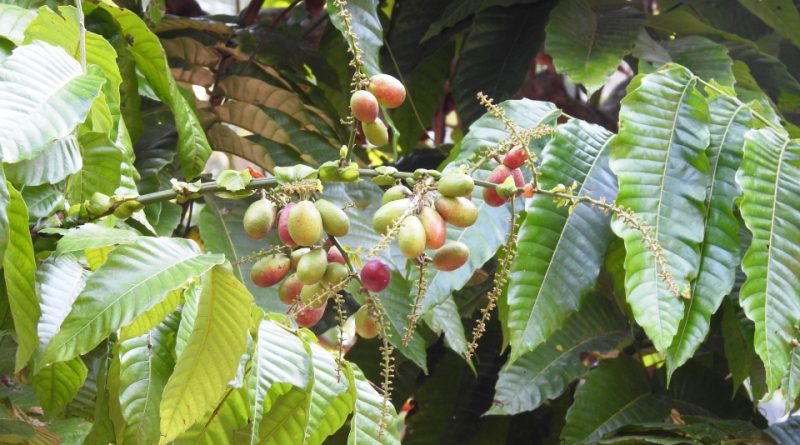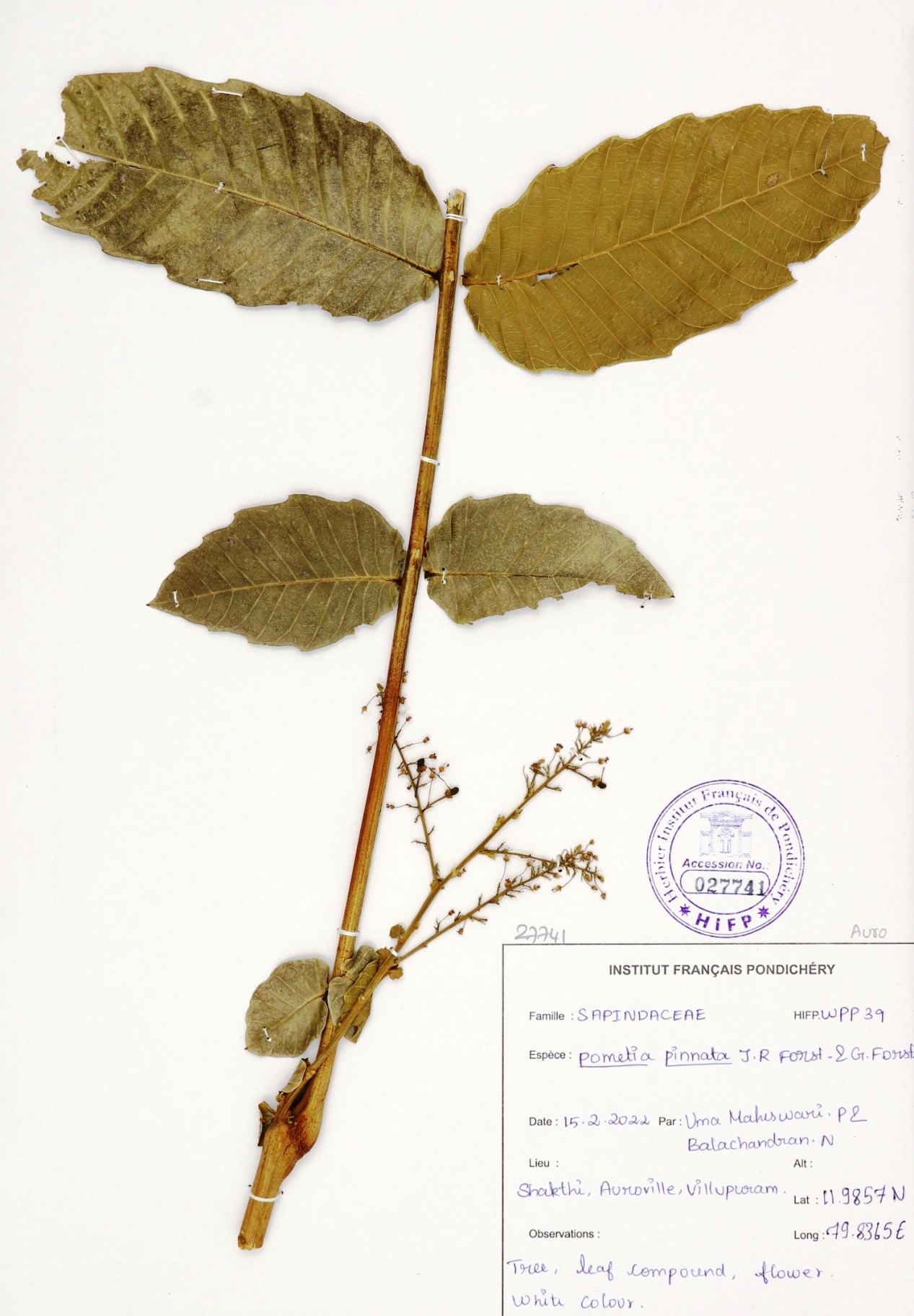Pometia pinnata
Pometia pinnata
The matoa or taun tree, island lychee, tava, Pacific lychee, Fijian Longan, island lychee kasai, megan, oceanic lychee (Pometia pinnata J.R. Forst. & G. Forst. 1775) is an arboreal species belonging to the Sapindaceae family.
Systematic –
From a systematic point of view it belongs to:
Eukaryota domain,
Kingdom Plantae,
Spermatophyta Superdivision,
Division Magnoliophyta,
Class Magnoliopsida,
Subclass Rosidae,
Sapindales Order,
Sapindaceae family,
Subfamily Sapindoideae,
Tribe Nephelieae,
Genus Pometia,
Species P. pinnata.
The terms are synonymous:
– Aphania neoebudica Guillaumin;
– Aporetica pinnata (J.R.Forst. & G.Forst.) DC.;
– Cnesmocarpus excelsus Zipp.;
– Cnesmocarpus excelsus Zipp. ex Blume;
– Dabanus acuminatus (Hook.fil.) Kuntze;
– Dabanus pinnatus (J.R.Forst. & G.Forst.) Kuntze;
– Diplocardia excelsa Zipp.;
– Diplocardia excelsa Zipp. ex Blume;
– Dubanus acuminatus (Hook.fil.) Kuntze;
– Dubanus pinnatus (J.R.Forst. & G.Forst.) Kuntze;
– Euphoria pinnata (J.R.Forst. & G.Forst.) Paxton;
– Euphoria pinnata (J.R.Forst. & G.Forst.) Poir.;
– Euphoria pometia (J.R.Forst.) Poir.;
– Irina alnifolia Blume;
– Irina diplocardia Blume;
– Irina glabra Blume;
– Irina tomentosa var. alnifolia (Blume) Miq.;
– Irina tomentosa var. cuspidata Blume;
– Nephelium acuminatum Hook.fil.;
– Nephelium diplocardia (Blume) F.Muell.;
– Nephelium pinnatum (J.R.Forst. & G.Forst.) Cambess.;
– Ornitrophe pinnata (J.R.Forst. & G.Forst.) Poir.;
– Pometia acuminata (Hook.fil.) Radlk.;
– Pometia alnifolia (Blume) King;
– Pometia coriacea Radlk.;
– Pometia glabra (Blume) Teijsm. & Binn.;
– Pometia gracilis King;
– Pometia lecomtei Gagnep.;
– Pometia macrocarpa Kurz;
– Pometia pinnata f. acuminata (Hook.fil.) Jacobs;
– Pometia pinnata f. alnifolia (Blume) Jacobs;
– Pometia pinnata f. cuspidata (Blume) Jacobs;
– Pometia pinnata f. glabra (Blume) Jacobs;
– Pometia pinnata f. macrocarpa (Kurz) Jacobs;
– Pometia pinnata f. repanda Jacobs;
– Pometia pinnata var. javanica Koord. & Valeton;
– Pometia tomentosa var. cuspidata (Blume) Britten;
– Pometia tomentosa var. ferruginea Hiern;
– Prostea pinnata (J.R.Forst. & G.Forst.) Cambess.;
– Schmidelia pinnata (J.R.Forst. & G.Forst.) DC..
Within this species some authors recognize two forms:
– Pometia pinnata f. pinnata;
– Pometia pinnata f. tomentosa (Blume) Jacobs.
Etymology –
The term Pometia is in honor of the French pharmacist and botanist Pierre Pomet (1658-1699) who traveled to Italy, Germany, Great Britain and the Netherlands and where he collected specimens, recipes and knowledge.
The specific epithet pinnata comes from the Latin “pinnatus, a, um”, that is, feathery, winged, in reference to the pinnate leaves.
Geographic Distribution and Habitat –
Pometia pinnata is a plant native to China (Yunnan) and present in Fiji, the Philippines, Indonesia, the Andaman Islands, the Nicobar Islands, the Solomon Islands, the Wallis and Futuna Islands, Laos, Malaysia, Niue, Papua New Guinea, Sri Lanka, Thailand, Taiwan, Tonga, Vanuatu and Vietnam.
This plant was transported into prehistory during the Austronesian expansion into Polynesia, as evidenced by the related local names used on islands ranging from Sulawesi to Niue.
Its preferential habitat is that of humid forests, from sea level up to around 1700 m above sea level, in areas characterized by high rainfall well distributed throughout the year. It is common in lowland forests, forest edges, open woodlands, lava flows, and often cultivated in Pacific Island villages.
Description –
Pometia pinnata is an evergreen tree that grows up to a height of 40-50 m, especially in old specimens that grow in their natural state.
The trunk is cylindrical, with a circumference up to over 1 m in diameter, provided at the base with tabular roots (flattened roots similar to buttresses); the bark is yellowish brown to reddish in color from whose wounds a red resin exudes.
The leaves are alternate and paripinnate, up to 1.2 m long, composed of 4-16 pairs of subopposed leaflets, the first pair orbicular, about 3 cm long, the subsequent ones oblong with a tight margin, pointed apex and parallel lateral veins , 15-35 cm long and 5-12 cm wide, leathery, of a shiny intense green color above, pale green below; the young leaves are pink to reddish brown and tomentose.
The inflorescences are panicle-shaped; they grow in a terminal or axillary position, generally erect, 20-70 cm long, bearing simultaneously present unisexual flowers, each with rudimentary organs of the other sex.
The flowers have a bell-shaped calyx with 5 lobes about 1 mm long, greenish-white obovate-triangular petals, 2 mm long, male flowers with 5 prominent stamens, 4-6 mm long, and red or yellow anthers: the female flowers have a bilobed bilobed ovary, pubescent, and style about 5 mm long.
The fruit is indehiscent, ellipsoid to subglobose in shape, with a more or less thin pericarp of a greenish yellow to shiny blackish brown color, depending on the variety, 3-5 cm in length and 2-4 cm in diameter.
Inside there is a single globose seed, 2-2.5 cm long and about 1.5 cm in diameter, oily, partially surrounded by a white to slightly pink aril, translucent, with a pleasant and delicate flavour.
Cultivation –
Pometia pinnata is a large, fast-growing evergreen tree that is occasionally grown in its native range for its edible fruit.
It is a plant of lowland humid tropical areas, usually found at altitudes below 500 meters, although occasionally it can be found up to 1,700 meters.
In its native range it grows in climates with an average annual rainfall between 1,500 and 5,000 mm, without a true dry season.
The average annual temperature is between 22 and 28 °C, the average maximum between 25 and 32 °C and the minimum tolerated between 5 and 16 °C.
From a pedological point of view, it prefers deep, rich and moist soil and a position in full sun or light shade. The tree is found on a variety of soils in its native range: on calcareous, loamy, sandy or loamy soils, mainly in dry forests, occasionally in freshwater swamps.
It is a very fast growing tree with height increases of 1.7 meters recorded per year.
The plant is widespread in the forests of the Pacific islands, where it sometimes represents the dominant species, often grown in family gardens and near villages, to reduce the transport times of its fruits to the markets, as they are quickly perishable.
Furthermore, its ornamental characteristics should not be underestimated due to its large and lush leaves and it is often used in its areas of origin as a shade tree in parks and gardens and in street trees.
Propagation occurs by seed, removed from the aril, and planted as soon as it is removed from the fruit, having a short duration of germination, if not appropriately preserved, in particularly draining organic soil kept humid at a temperature of 24-26 °C; it can also be reproduced by cutting.
Customs and Traditions –
Pometia pinnata is a plant known by various common names; among these are: Fijian longan, island lychee kasai, megan, oceanic lychee (English); fan long yan shu (China); ndawa, tawa (Fiji); agupanga, malugai, tugaui (Philippines); kasai, matoa, sibu (Indonesia); tava (Solomon Islands); matoa, obahu, taun (Papua New Guinea); kava, tava (Samoa); daeng-nàam (Thailand); tava, tava moles (Tonga); nandao, natsaria, nendo, rao, tava (Vanuatu); truong, truong maat (Vietnam).
In addition to the fruit pulp, consumed fresh, the seed is also sometimes consumed boiled or roasted.
Bark and leaves are used in the areas of origin in traditional medicine for various pathologies; Laboratory studies have highlighted the presence of compounds with antioxidant properties in bark and wood worthy of further investigation.
The wood, pink in color tending to reddish if exposed to light, medium heavy and resistant, easy to work and finish, is used, both locally and exported, for internal parts of homes, for boats, furniture, boxes and everyday objects common, it is also excellent for burning and for producing charcoal.
The heartwood is not clearly delimited from the band of lighter sapwood, 3 – 5 cm wide. The texture is medium; the grain is straight or intertwined, sometimes wavy; the surface is shiny; there is a brownish resin. The wood is moderately heavy; moderately hard; moderately strong; not very durable, having some resistance to fungi and termites but susceptible to dry wood borers. It cures rather slowly, with a high risk of cracking and distortion, but once dry it is stable in service. It can be worked with normal tools, although it may present some difficulties due to the woven or wavy fibre; planed surfaces are sometimes rough and may require filling; nailing and screwing is good; the gluing is correct.
It is, however, a good lumber for general use; for interior construction, it is also suitable for domestic flooring, mouldings, carpentry, ship and boat building, spars, tool handles, agricultural and sporting tools, interior finishes, battens and narrow barrels. It is well accepted for making boxes and crates. In outdoor constructions, contact with the ground must be avoided as wood is not durable. The timber can be used for furniture and cabinetry, but must be dried to a sufficiently low moisture content. It is suitable for hardboard and chipboard and as wood pulp. A good quality veneer is obtained from the wood which can be used as a decorative veneer and is very suitable for middle and outer layers of plywood.
Furthermore, rubber obtained from the inner bark is used to waterproof canoes.
A hair shampoo is also obtained from the bark.
Preparation Method –
Pometia pinnata is a plant used for food, medicinal, ornamental purposes and for its wood.
In food use, the fruits are consumed raw.
The semi-transparent white pulp is aromatic, juicy and sweet, with a pleasant flavor which, according to some, has the flavor of rambutan.
Oilseeds are consumed after boiling or roasting.
In the healing field it is often used in traditional medicine in the Pacific Islands[.
It is used to treat deep bone pain, migraines, to promote the expulsion of the placenta after childbirth, to relieve rheumatic pain in the muscles and joints, to relieve fever, as a remedy against flu and colds, to cure diarrhea, stomach upset, cough, fever, constipation and diaper rash.
The leaves are antimicrobial. A decoction of leaves or bark is used medicinally against fever and sores.
An infusion of the leaves is rubbed on the head of newborns or administered internally to treat unclosed fontanelles.
An abundant, thin, red gum obtained from the inner bark is believed to have many medicinal properties.
An infusion of the bark is used as an emetic for mouth infections, colds and mucous membrane congestion and to treat abdominal pain.
A decoction of the bark is used to treat mouth tumors.
Guido Bissanti
Sources
– Acta Plantarum – Flora of the Italian Regions.
– Wikipedia, the free encyclopedia.
– GBIF, the Global Biodiversity Information Facility.
– Useful Tropical Plants Database.
– Conti F., Abbate G., Alessandrini A., Blasi C. (ed.), 2005. An annotated checklist of the Italian vascular flora, Palombi Editore.
– Pignatti S., 1982. Flora d’Italia, Edagricole, Bologna.
– Treben M., 2000. Health from the Lord’s Pharmacy, Advice and experiences with medicinal herbs, Ennsthaler Editore.
Photo source:
– https://inaturalist-open-data.s3.amazonaws.com/photos/336321252/original.jpeg
– https://www.ifpindia.org/hifp/images/HIFP_027741.JPG
Attention: Pharmaceutical applications and food uses are indicated for informational purposes only, they do not represent in any way a medical prescription; we therefore decline any responsibility for their use for healing, aesthetic or food purposes.


